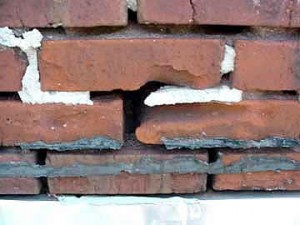Masonry Repairs and Tuckpointing
Your chimney is designed to outlast your house. However, neglecting maintenance and natural occurrences can cause chimney problems that shorten its life. A long winter, for instance, can damage masonry. This is especially true if the chimney hasn’t been properly waterproofed.
Water and Your Masonry
Masonry is constructed of many materials that are adversely affected by water. Unfortunately, even a small amount of water can cause big damage, especially during winter. When water penetrates the masonry, it is subject to a freeze/thaw cycle that damages the chimney’s structure. The water freezes when temperatures drop, expanding and busting the masonry. Afterwards, melting when temperatures rise, allowing the water to flow deeper into the damaged masonry. This process is repeated until it causes serious damage!
Common Masonry Damage
- Spalling – The freeze/thaw cycle causes spalling. This means the mortar cracks and falls away and bricks flake, thus leaving holes in your chimney.
- Water Damage – Water damage can vary from serious, structural issues to simple stains on the interior or exterior of the chimney system.
Chief Chimney Services has been serving the Suffolk County area for over 20 years. During spring inspections, our technicians often find winter damage that require repairs.
Chief Chimney Services Repairs Your Masonry
- Tuckpointing – Perhaps the most common masonry repair our technicians see is tuckpointing. Our skilled masons remove damaged mortar and bricks and replace them with new mortar for a clean, restored look. This process can be tedious because the new mortar must match the old in consistency, strength, and color. Failing to match the mortar perfectly can mean weaker masonry!
- Rebuild – Less common that tuckpointing, but still important, is the masonry rebuild. For the chimneys that have been grossly neglected or badly damaged due to natural disasters or fire, our masons can rebuild them beautifully.
- Firebox Repair – The firebox withstands the most abuse and often gets the least attention. The firebox keeps the fire in its place, though, so you need it to do its job, and do it well! During your chimney sweep, our technician can spot a problem before it becomes a hazard, and plan accordingly.
- Chimney Crown Repair – The chimney crown also withstands abuse, topping your chimney and keeping out weather and critters. The crown can become damaged because it hasn’t been waterproofed, because of age, or because it wasn’t properly constructed. Whatever the cause, Chief Chimney Services can replace it with a recast chimney crown that is beautiful and functional!
When it’s time to close out your chimney for the off-season, you want to make sure it’s ready for fall. Don’t spend your summer fretting over your chimney repairs. Get your inspection this spring so you can schedule necessary repairs as well. At Chief Chimney Services we put our customers first, and we want your chimney to be ready and safe for fall.
Schedule your appointment now!

